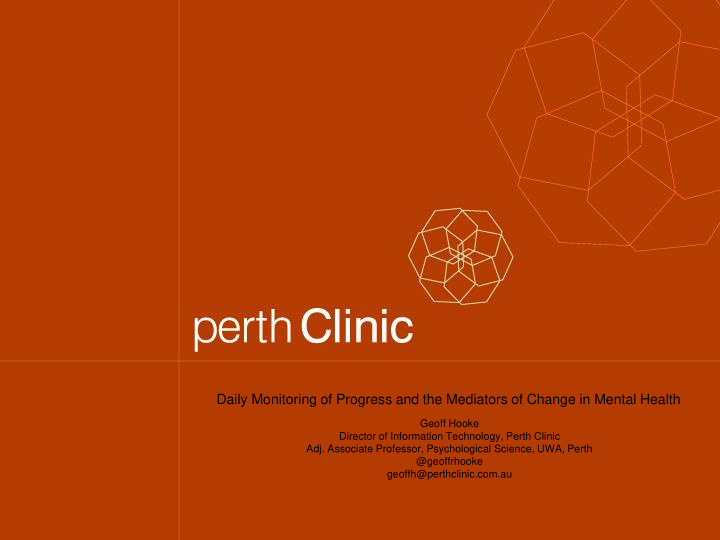



Daily Monitoring of Progress and the Mediators of Change in Mental Health Geoff Hooke Director of Information Technology, Perth Clinic Adj. Associate Professor, Psychological Science, UWA, Perth @geoffrhooke geoffh@perthclinic.com.au
Presentation Plan What is Old news. What is New! Why monitor patient progress Monitoring at Perth Clinic – Improving Patient Outcomes – New in Mental Health! Method of giving feedback, live system – New! Trajectories of expected outcome, automated – New! If “off track” how about mediators/process? – Very New! Self harm prediction project – Very Very new!
Setting the Scene • 100 bed Inpatient Private Mental Health hospital – Western Australia • Inpatient, day-patient, outpatient and outreach services – ~ 60 day patients per day 5
What is Old! End of treatment, follow up Graphs 6
OLD NEWS! Av erage DASS Depression For Patients With Affectiv e Disorders (1998-2003) 22 Severe Depression 20 18 DASS Depression 16 14 12 10 Normal Range 8 6 Pre-CBT Pos t-CBT 6W k F/U 3M F/U 12M F/U
Recovered Improved Deterioration (Newnham, Harwood, & Page, 2007)
Illustrative Patient Inpatient Stay Daypatient Rx Admission Discharge Pre-CBT Post-CBT Follow Up Acute Treatment Groups Cognitive-Behavioural Treatment HoNOS HoNOS HoNOS HoNOS HoNOS DASS DASS DASS DASS DASS MH-14 MH-14 MH-14 MH-14 MH-14 RSES QOL QOL RSES RSES LCB POC Audit LCB LCB CBT-POC (RAS) Daily Symptom Monitoring
A System was Developed – with Point of Care Access
Provided Access Throughout the Hospital Live, real time connectivity- MX component, clinical component Viewed in Nurses station – Patient location – group attendance or not Patient progress available in number and graph Suicide thinking item choice - visible
Nursing – Daily Monitoring
CBT Closed Group Patient Graph 13
Feedback Feedback can be • given at the point of care or in printed form
Mobile Access
Now IPad in every Inpatient Bedroom = 100 Ipads.
Inpatients & Day patients: Improved outcomes (F(1,649) = 6.29, p = .01) Vitality: (F(1,639) = 5.53, p = .02) Role Emotion: Newnham, E.A., Hooke, G.R., & Page, A.C. (2010) (F(1,635) = 4.11, p = .04) Journal of Affective Disorders
Therapist iPad View – Daily Schedule
VERY NEW!!
Patient had minimal change, some correlation with better outcome and greater practice.
CBT Skills “Use”, asked Daily Over the last day, I used the skills from the CBT course when I needed them.. Figure 2: Mean and standard error ratings for the Use of CBT skills item for each clinical significance group
CBT Skills “Effective”, asked Daily Over the last day, the CBT skills I used were effective… Figure 3: Mean and standard error ratings for the Effectiveness of CBT item for each clinical significance condition.
Use of CBT Skills - For average use, symptoms at day 1 remained a significant predictor, however the variance in symptoms at day 10 explained increased to 32%. So Use is a partial mediator. Figure 5: Figure depicting mediation model with path coefficients for Average Use of CBT skills Use Use a = -.08* b = -.34* * Symptoms day 1 Symptoms day 10 b = -.34* * Symptoms day 1 Symptoms day 10 c’ = .50* * c’ = .50* *
VERY VERY NEW!! Dual Approach (All data plus 7 extra questions) 1. Predicting Self harm (binary alert) in Inpatients, intervening, reducing. - UWA Maths Dept, YLM. Daily measures + Self harm data (Riskman) 2. Providing a treatment option for those identified of suicidal thinking that utilizes Interpersonal Therapy. (Thwarted belonging and perceived burdensomeness)
VERY VERY NEW!! Self Harm Prediction – Joint Project with UWA Mathematics Dept
In Summary Small organization Our strength is agility and customization, using in house developers Multi-disciplinary team, I.T., therapy, nursing, Mx Have to be innovative, can’t wait for others to develop concepts, so we have to develop our own Thereby we can accommodate patient and staff requests quickly In house research team, linked to UWA Psychology and Mathematics Depts, Ph.D. students involved, 11 have completed. So far 42 publications
The End Geoff Hooke https://www.researchgate.net/profile/Geoffrey_Hooke Email: Geoffh@perthclinic.com.au Twitter: @geoffrhooke
Recommend
More recommend